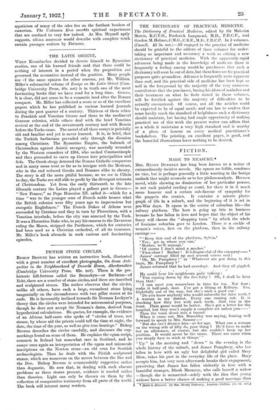PICTISH STONE CIRCLES.
Brsnor BRowws has written an instructive book, illustrated with a great number of excellent photographs, On Some Anti- quities in the Neighbourhood of Dunecht House, Aberdeenshire (Cambridge University Press. 63s. net). There is the pre- historic hill-fortress called the Barmekpr—or Barbican—of Echt, there are a number. of stone-circles, and there are inscribed and sculptured stones. The author observes that the circles, unlike all others, have each a large, recumbent stone lying tangentially on the circumference with two pillar stones at its ends. He is favourably inclined towards Sir Norman Lockyer's theory that the circles were intended for astronomical purposes, though he does not accept Sir. Norman's dates, derived from hypothetical calculations. He quotes, for example, the evidence of an African half-caste who spoke of " circles of trees, not stones, by whose aid. the priests could tell the time at night, the date, the time of the year, as well as give true bearings." Bishop Browne describes the circles carefully, and discusses the cup- markings found on some of them. He explains the ogam script, common in Ireland but somewhat rare in Scotland, and he essays once again an interpretation of the ogam and minuscule inscriptions on the Newton stone—an old crux for Scottish archaeologists. Then he deals with the Pictish sculptured stones, which are numerous on the moors between the Dee and the Don. Bishop Browne is commendably suggestive rather than dogmatic. He sees that, in dealing with such obscure problems as these stones present, evidence is needed rather than theories. Light oan only be thrown on them by the collection of comparative testimony from all parts of the world. The book will interest many readers.










































 Previous page
Previous page